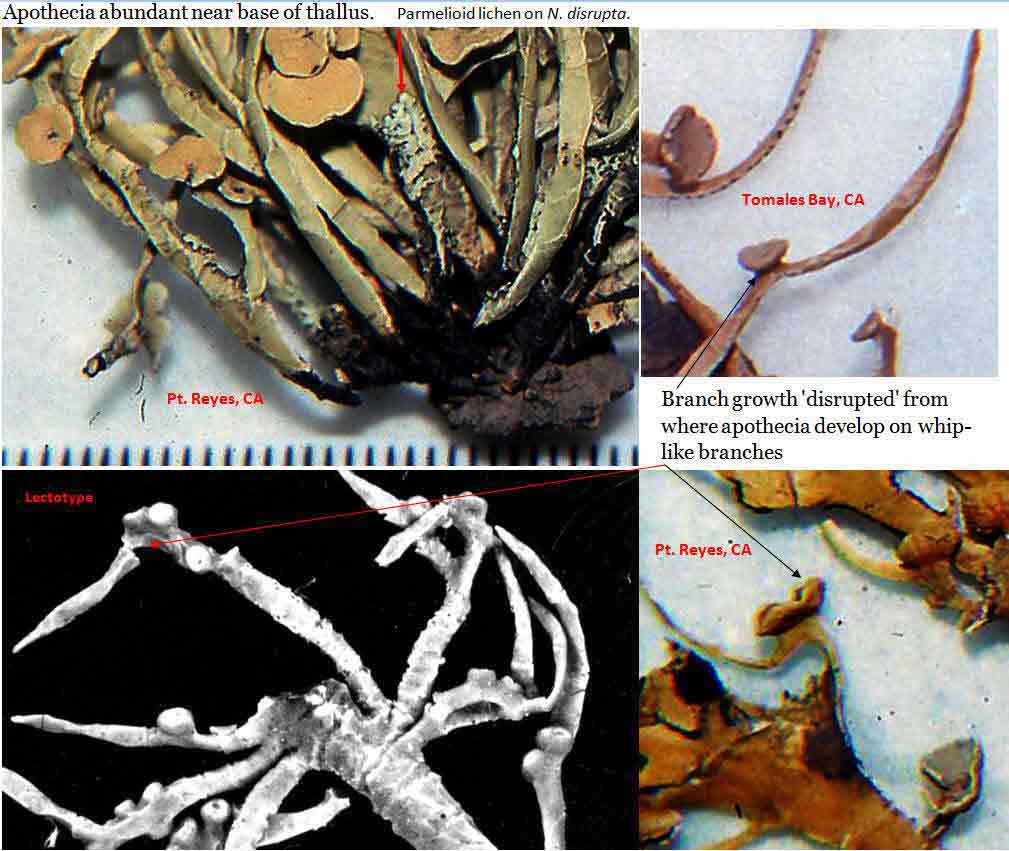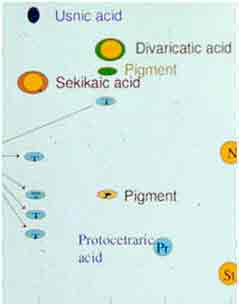Niebla disrupta is a fruticose lichen that has been recognized to
occur largely in coastal areas of
California. The geographical range
of N. disrupta partially overlaps with N. homalea in the
Channel Islands and on
Isla Guadalupe in Baja California and on the mainland from San
Luis Obispo to Mendocino Cos. It is notably absent south of Morro Bay.
The type locality is not specifically known; however, the type specimen
compares most closely to specimens from coastal Marin County, while the
collector and collection date are also unknown. The type would appear to
be a fragment of a specimen from perhaps the Museum of Natural History
in Paris
Niebla disrupta is morphologically similar to
N.
homalea from which it is distinguished by having sekikaic acid
and not divaricatic acid. Despite their similar
morphology, chemistry, and geographical distribution, they are not
sibling species. DNA phylogeny studies by Spjut et al. (2020) and
Jorna et al. (Authorea. Apr 2021)
reveal that species of Niebla producing sekikaic acid form a
separate clade; however, sekikaic acid specimens have not been
reportedly collected in California for the DNA studies.
Niebla disrupta
may be recognized morphologically by the terminal
whip-like, often sharply pointed branchlets, usually with undeveloped apothecia,
while mature apothecia develop nearer the base of
thallus. The whip-like branches often change direction
where apothecia initiate. Niebla homalea, in contrast, has
mostly ribbon like branches with apothecia maturing nearer apex, usually
elevated on a short broad flat lobe. Both species may occur together as evident from herbarium
collections.
Variants assigned to this species include specimens
collected by Charis Bratt 5182 from Santa Barbara Island and by Reifner
86-25 (Fig. 8.4 in Spjut 1996) from Morro Bay, and possibly
a Stephen Sharnoff photo titled “Niebla homalea 4” reportedly taken on Santa Rosa Island. These 'disruptoid' nieblas,
which share
the terminal whip like branches with subterminal apothecia, are similar to
N. suffnessii that differs by the
more rounded branches in x-section with a thinner cortex; however, they
appear to belong to a separate undescribed southern California species
complex that includes variants of N.
cornea, N. dissecta,
N. laminaria, and possibly
N. lobulata; the latter has not been
recognized from California.
The
two Niebla
disrupta variant specimens mentioned above have an irregular network of
cortical ridges between branch margins; the branches appearing 3–4 angled in cross section
as seen in N. dissecta, a
species recognized by a broader than tall thallus and terminal wide-spreading
branchlets arising from dilated branches.
The apothecia are larger and positioned more on the face of the branch
rather than perpendicular to an expanded margin of the branch. They are referred to N.
disrupta by the thallus appearing taller than wide, and by the
terminal whip-like branches as just noted. This variation may be a
product of geographical (evolutionary)
differentiation of N. disrupta south of Monterrey Co. that
involved genetic exchange with variants of
N. cornea occurring further south and
on Santa Barbara Island, N. laminaria at Pt. Loma, and N.
aff. lobulata in the Santa Monica Mts.
A
related
sekikaic acid species, Niebla
fimbriata, has spindle-shaped branchlets that are
relatively straight in a wind-swept appearance along one or
both margins of an aching branch, analogous to “scorpiod cyme (seund) type of
inflorescence in angiosperms.
The
sekikaic-acid species considered most similar to N. disrupta
are Niebla cornea
and N. dissecta. They are distinguished in the
following table, diagnostic characters in bold type.
|
Character |
N. disrupta |
N. cornea |
N. dissecta |
|
|
|
|
|
|
Branching general |
Anisotomic. |
Anisotomic. |
Anisotomic. |
|
Terminal bifurcate
branches |
Usually not evident. |
Bifurcate
and rabbit-like ear-lobes, or
trifurcate with unequal lobes, or often expanded with digitate-like
segments |
Common,
antler-like, often 3-pointer in one division, 2-pointer on
other, more flattened and digitate in type |
|
Branch shape lengthwise |
Sublinear. |
Scoop-like
to ribbon-like |
Sublinear
with expanded lobes, especially near apex. |
|
Branch shape cross-section |
Elliptic or 3–4 angled in one variant |
Elliptic. |
Prismatic, or
±4-angled. |
|
Branches twist |
Frequent between base and apex. |
Irregularly twisted or not twisted, often
irregularly contorted. |
Frequent between base and apex. |
|
Branch margin |
Usually well-defined, acute. |
Rounded to acute, sometimes thickened. |
Variable. |
|
Cortex |
Glassy, transversely cracked at various intervals. |
Mostly smooth, irregularly transversely cracked or
reticulate ridged |
Dull, transversely cracked and reticulate ribbed with
tertiary longitudinal sinuous ridges between the
margins. |
|
Apothecia |
Subterminal undeveloped apothecia on long whip-like branches,
mature apothecia often on lower short lateral branches,
oriented perpendicular to
branch margins, shorter branches often at nearly right
angles. |
Terminal in small loose aggregates, often in 4's on
short lobes of an expanded branch, or sessile and in plane with the
main branch. |
Generally
most developed near base of thallus, sessile, submarginal. |









